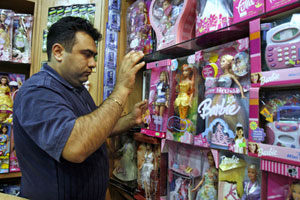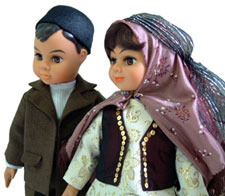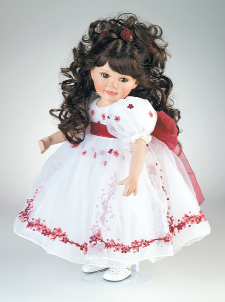Writing a doll blog makes me supersensitive to what is selling and what is percolating in the toy industry. Hoping to brew a finely tuned sense for what is going on, I’m also called upon to meditate and ruminate on all these developments and how they impact our daily lives. So, blending the practical (doll sales) with the philosophical (my blog ramblings), if a doll DOESN’T sell in the forest of toy stores and websites, does it still make a sound? In the case of this week’s blog, it makes an even bigger sound than you could ever imagine.
The month of January concluded with two major non-sales headlines. One was the “polite” pressure exuded by Apple and the Jobs family to prevent a Steve Jobs doll from coming to market. The other was a report on how the Iranian mullahs are once again ordering crackdowns on Barbie doll sales in their country’s toy stores and retail shopping centers.
pressure exuded by Apple and the Jobs family to prevent a Steve Jobs doll from coming to market. The other was a report on how the Iranian mullahs are once again ordering crackdowns on Barbie doll sales in their country’s toy stores and retail shopping centers.
 Now, if you were going to pen a piece that highlights the rise of popular culture in the 2000s, it wouldn’t be complete without Steve Jobs, a visionary who took a onetime piece of office hardware and morphed it into something more. Standing on the opposite side of pioneering technology would be the rise of Islamic-centric governments that view progress as seeds of Western invasion, and go out of their way to suppress and stamp down upon any inklings of American and European influence.
Now, if you were going to pen a piece that highlights the rise of popular culture in the 2000s, it wouldn’t be complete without Steve Jobs, a visionary who took a onetime piece of office hardware and morphed it into something more. Standing on the opposite side of pioneering technology would be the rise of Islamic-centric governments that view progress as seeds of Western invasion, and go out of their way to suppress and stamp down upon any inklings of American and European influence.
How odd, then, that Apple and Steve Jobs’s heirs would blend together to cry “foul” about the unveiling of a Jobs realistic effigy. Created by the In Icons company, the doll was 12 inches tall, was dressed in the computer giant’s trademark turtleneck and jeans, and had an uncanny resemblance to the CEO who was never shy about showboating or promoting during his lifetime. When you look at the doll and its expression—even its ability to contort into some kind of strange yoga-meets-Tim-Tebow curtsey—one has to be impressed with how attractive, realistic, and lifelike the doll appears. It is not a caricature or a parody or some rushed-out-for-a-quick-buck concoction. This was a lovingly rendered doll by a fan of Steve Jobs who had spent four years perfecting it for his own personal collection. When Jobs passed away, the artist decided to put the doll on the market and share the work with other Apple admirers.
In the world of cyber technology, Apple and its branding carries enormous clout, and it doesn’t tolerate people trying to get a bite of its loot. So, the advertised action figure was met with public displeasure—the company executives and the deceased’s relatives all spoke disparagingly of the work. The action figure lingered for a while in limbo, until the legal injunctions converted it into an inaction figure, once and for all.
Priced at $100 when it was up and running from late October to mid January, plans to promote and sell have all been shelved. Rumors swirl that a few of these dolls made it into the marketplace and are selling for over $2,000 each.
If that’s the case, I can’t imagine that the granddaddy of all price setting and the purveyor of “high prices equal perceived quality” would mind that at all. A $100 doll representing the uber wealthy Jobs—don’t be ridiculous. A $2,000 version? That’s much more in step with his bank account and ego.
Heading, then, from Silicon Valley to the Valley of the Kings, a person sees a huge difference in attitudes and acceptable codes of behavior. However, the latest tempest in a teapot has much in common with the Jobs suffocation of the action doll.
In Iran, entrepreneurs who manage to stock their shelves with Barbie dolls—she’s been an enemy of the state since the late 1990s—are once again being pressured to cease and desist. News agencies are posting responses from moms and dads who buy the Barbies for their daughters. Overwhelmingly, it’s a case of parents who see themselves as being progressive being overrun by a state’s crackdown.
once again being pressured to cease and desist. News agencies are posting responses from moms and dads who buy the Barbies for their daughters. Overwhelmingly, it’s a case of parents who see themselves as being progressive being overrun by a state’s crackdown.
 Knowing that children love to play with dolls, and want to change costuming and give them all sorts of make-believe back stories, the Iranian government has a sanctioned, allowable pair of dolls: Dara (a male) and Sara (a female).
Knowing that children love to play with dolls, and want to change costuming and give them all sorts of make-believe back stories, the Iranian government has a sanctioned, allowable pair of dolls: Dara (a male) and Sara (a female).
Unlike the Mattel coupling of Barbie and Ken, Dara and Sara prefer modest dressing and are well-tailored from headdress to toe. Over the years, Malibu Barbie and Ken have risked near-cancerous suntan exposure with their ray-kissed limbs and torsos. Dara and Sara never have to fear sunburns or out-of-control freckling. Instead, they have to contend with Sharia Law and international embargoes.
well-tailored from headdress to toe. Over the years, Malibu Barbie and Ken have risked near-cancerous suntan exposure with their ray-kissed limbs and torsos. Dara and Sara never have to fear sunburns or out-of-control freckling. Instead, they have to contend with Sharia Law and international embargoes.
 What’s interesting is how the selling of dolls—the most benign of all creations in so many ways—has united two different international perspectives. For a theocracy that frowns on personal freedom, and a democracy that celebrates individual achievement, their polar opposite mind-sets have both turned doll sales into a minefield of worries, fears, accusations, and censorship.
What’s interesting is how the selling of dolls—the most benign of all creations in so many ways—has united two different international perspectives. For a theocracy that frowns on personal freedom, and a democracy that celebrates individual achievement, their polar opposite mind-sets have both turned doll sales into a minefield of worries, fears, accusations, and censorship.
Just a couple of years ago, Apple ran an ad that partially declared: “Here’s to the crazy ones. The misfits. The rebels. The troublemakers. The round pegs in the square holes. The ones who see things differently. They’re not fond of rules. And they have no respect for the status quo. You can praise them, disagree with them, quote them, disbelieve them, glorify or vilify them. About the only thing you can’t do is ignore them. Because they change things.” http://www.youtube.com/watch?v=cFEarBzelBs
How funny that the doll maker at In Icons was too much of a troublemaker for the powers that be at Apple. I guess it pays to be a misfit and a rebel, if you are trafficking with circuit boards, but not with ball joints.
and a rebel, if you are trafficking with circuit boards, but not with ball joints.
And for the ruling class in Iran, imagine how surprising it would be if the pink-boxed Barbie struck a blow for freedom. After more than a decade of pushing her out of the marketplace, she always comes back for more. No matter the prohibitions, the Iranian doll-buying public likes Barbie’s obvious inhibitions.
Some rebels just can’t be ignored.









